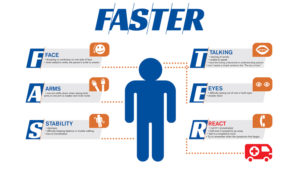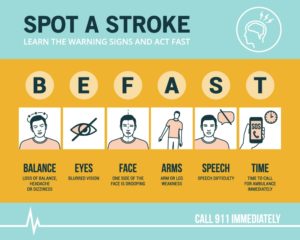 OR
OR
F stands for Face, which refers to drooping or numbness on one side of the face versus the other. Ask the person to smile to make the droop more apparent.
A stands for Arms, which refers to one arm being weaker or more numb than the other. Ask the individual to raise both arms up and hold them for a count of ten. If one arm falls or begins to drop, then this could be a sign of a stroke.
S stands for Stability, which refers to steadiness on your feet. Sometimes individuals will fall, feel very dizzy or be unable to stand without assistance. Difficulty maintaining balance, trouble walking and loss of coordination are all possible stroke symptoms.
T stands for Talking, which refers to changes in speech including slurring, garbled, nonsensical words, or the inability to respond appropriately. Individuals experiencing a stroke may be difficult to understand, or they may have difficulty understanding others. Ask the person to repeat a simple sentence like “The sky is blue.”
E stands for Eyes, which refers to visual changes. These visual changes occur suddenly and can include complete vision loss in one eye, double vision, and partial loss of vision in one or both eyes.
R stands for React, which is a reminder to call 911 immediately if you recognize any of these symptoms. Call even if the symptoms go away and try to remember when they first began..
Identifying and reacting to stroke symptoms quickly is crucial to achieving proper treatment for an individual experiencing a stroke.
Acute stroke treatments are time dependent after a stroke occurs. This is why it is so important to recognize stroke symptoms quickly and act FASTER by calling 911 immediately. FASTER is also known as BEFAST by certain hospital facilites that cover the exact areas in determining a stoke (see the pictures above).!
The stroke experts at Beaumont Health created an updated acronym – FASTER – which adds two additional, but key, stroke symptom indicators.
The acronym FAST (Facial drooping, Arm weakness, Speech difficulties and Time) has been used by the National Stroke Association, American Heart Association and others to educate the public on detecting symptoms of a stroke. FAST was first introduced in the United Kingdom in 1998.
“FASTER is a new acronym reiterating the importance of quickly recognizing the signs and symptoms of a stroke and calling 911,” says Rebbeca Grysiewicz, D.O., director of the Comprehensive Stroke Center at Beaumont Hospital, Royal Oak. “
Beaumont added ‘stability’ and ‘eyes’ when we created FASTER because sudden imbalance and/or vision loss are also important and recognizable symptoms of a stroke. Identifying symptoms and reacting quickly helps ensure early arrival to the hospital for assessment of potential stroke treatment.”
Remember the sooner the pt gets to the hospital based on the hours the stroke symptoms happen or began will determine the treatment! For strokes due to a blockage called ischemic stroke the symptoms have to be within 3 hours for TPA or in some cases 4 hours or TPA can not be used and the pt is immediately sent to just the stroke unit. If the stroke is hemorrhagic than the OR is the only immediate treatment to close the hemmorage in the brain. Also, depending on the severity of the hemorrhage in the brain the pt is more limited in time a recovery of any can be terribly affected; especially if the hemorrhagic stroke happened outside of a acute hospital with how soon it was detected, called in to 911 and reached the acute hospital. TIME is of ESSENCE!!
